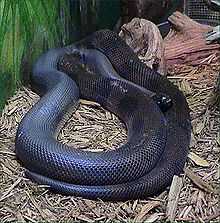Bothrochilus
| Bothrochilus | |
|---|---|
 | |
| Scientific classification | |
| Kingdom: | Animalia |
| Phylum: | Chordata |
| Subphylum: | Vertebrata |
| Class: | Reptilia |
| Order: | Squamata |
| Suborder: | Serpentes |
| Family: | Pythonidae |
| Genus: | Bothrochilus Fitzinger, 1843 |
| Species: | B. boa |
| Binomial name | |
| Bothrochilus boa (Schlegel, 1837) | |
| Synonyms | |
| |
- Common names: Bismarck ringed python[2]
Bothrochilus is a monotypic genus containing the nonvenomous python species, B. boa, found on the islands of the Bismarck Archipelago. No subspecies are currently recognized.[3]
Description
Adults grow to a length of 152–183 cm (4.99–6.00 ft). The color pattern consists of a series of brilliant orange and black rings in juveniles, but this fades in about a year as the snakes mature. Adults are usually a shade of brown with black rings, or a uniform blackish brown. Usually, there is a light spot behind the eye.[2] Some specimens may have black rings that are irregular, incompletely formed or even absent. The scales are highly iridescent.
Geographic range
Found on the islands of the Bismarck Archipelago, including Umboi, New Britain, Gasmata (off the southern coast), Duke of York and nearby Mioko, New Ireland and nearby Tatau (off the east coast), the New Hanover Islands and Nissan Island, the type locality given is "Nouvelle Irlande" (New Ireland).[1]
Habitat
The Bismarck ringed python inhabits rain forests in open and/or cultivated areas,[2] and is often found in piles of coconut husks.
Behavior
These snakes are nocturnal and fossorial.[2]
Feeding
Their diet consists primarily of small rodents, for which they actively forage. They have been reported to enter houses and agricultural structures in search of prey. Hatchlings feed on lizards and juvenile rodents.[2]
Reproduction
Oviparous, they lay up to a dozen eggs that are generally "brooded" by the female, although this is not always the case.[2]
Captivity
Young specimens will often bite readily, but they usually settle down as they mature to become trustworthy captives. Wild-caught animals are not generally available. The species appears to be well-established in captivity, with several hundred ringed pythons hatching out from breeder's collections each year. Captive specimens seem to benefit if provided with a box of damp moss in which to occasionally sit. This species likes high humidity, but is intolerant of poor ventilation or wet conditions.
See also
- List of pythonid species and subspecies
- Pythonidae by common name
- Pythonidae by taxonomic synonyms
References
- ↑ 1.0 1.1 McDiarmid RW, Campbell JA, Touré T. 1999. Snake Species of the World: A Taxonomic and Geographic Reference, vol. 1. Herpetologists' League. 511 pp. ISBN 1-893777-00-6 (series). ISBN 1-893777-01-4 (volume).
- ↑ 2.0 2.1 2.2 2.3 2.4 2.5 Mehrtens JM. 1987. Living Snakes of the World in Color. New York: Sterling Publishers. 480 pp. ISBN 0-8069-6460-X.
- ↑ "Bothrochilus". Integrated Taxonomic Information System. Retrieved 9 September 2007.
External links
| Wikimedia Commons has media related to Bothrochilus boa. |
- Bothrochilus boa at the Reptarium.cz Reptile Database. Accessed 9 September 2007.